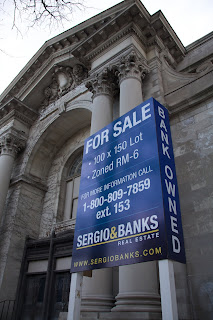 |
| Chicago, Illinois |
One of the most depressing things about living in Northeast Ohio is traveling about and observing how many church buildings are boarded up and closed, for sale, or in dire need of serious repair. I was driving to Lorain Cleveland Christ Church in Hudson
A dear friend of mine and scholar, The Reverend Bill Doubleday, recently posted a reflection on Facebook on this very subject. It is worth your reading so I have included it in my post. With gratitude to Bill and his wisdom, he writes:
“We now have entered an era where I hear more and more about church closings. One scholar I consulted, said that EACH YEAR – nationwide - across all denominations - nearly 4,000 churches are closed and significantly less than 2,000 are opened or planted. A growing number of the closures are small, often long struggling, Episcopal Churches, especially in the cities and in rural areas north of the Mason Dixon Line. Occasional, I hear about an Episcopal Church being planted somewhere in the Sunbelt where Christendom still holds sway to some extent – though probably not for too much longer.
 |
| New England |
 |
| Church Brew, Pittsburgh, Pennsylvania |
“These disused church buildings were normally reverently deconsecrated and then some church buildings were sold to another denomination, to another faith group, or even to a non-profit organization that could use the meeting space. Quite rarely those old churches were deployed for some definitely adaptive use like housing, offices, or commercial space. (If one travels to London or Amsterdam one sees far more adaptive use of the oversupply of disused churches – an oversupply not unlike the one steadily emerging in this country in both large and small communities as well.)
 |
| Tearing Down The Church |
“Sometimes those old church buildings were simply torn down and their holy objects and monuments were either given to sister churches or sold at auction. Sometimes those old church buildings stand empty for decades and one puzzles about who actually owns them, who keeps them secure or successfully boarded up, or whether there is anybody who still cares about the structure at all – usually the grass seems to get cut – perhaps miraculously by angels. It always makes me sad when a church building is torn down, but given all the deferred maintenance related to old churches, our nation and people may be safer as a result of their destruction.
“I believe that by the 1950’s, with the reign of the Christendom model of church and with mythic conceptions of the Mainline Churches, there were fewer church closures, except when a downtown parish moved to the outskirts of a community as a result of urban flight or when they desperately needed more parking spaces, or because some small rural community had essentially died and one or more churches simply gave up the ghost.
 |
| Memphis, Tennessee |
“With the turmoil of the 1960’s and 1970’s, some dioceses and bishops made a commitment to try not to close churches in embattled and struggling urban neighborhoods – “so that the church can continue to bear witness to God’s love and justice.” Some of those parishes thrive today; others look like padlocked bastions in the midst of drugs, crime, and deep poverty; still other churches have died or been eased out of their misery when the last of the old parishioners died, having failed to engage in any meaningful way with a drastically changing neighborhood and a profoundly different set of demographic realities.
“In recent years, the Mainline Churches has faced many financial, demographic, and social justice challenges. Reduced amounts of money from local congregations and dioceses continue to flow upward. Less and less money trickles down from denominational headquarters and dioceses toward the local congregations. Aging congregants are dying fast. Younger congregants – if they are present at all – do not necessarily embrace high stewardship levels towards the church, in part because there are so many causes that may seem as worthy as, more effective than, and less top heavy than the local church. Mission
 |
| Hickory, North Carolina |
In the first parish I served after seminary, the building and grounds were certainly a major focus of the congregation’s overall ministry. It was a gorgeous place to worship and the gardens made you feel like you were in England
 |
| Christ Church in Charlotte, North Carolina |
Another interesting aspect of that congregation was the notion and expectation that each Rector would lead a building campaign during his tenure. I believe that every Rector, except for Harcourt Waller, has in fact accomplished that task. Christ Church has always been a leader in social justice ministries in Charlotte
When I moved to Mooresville, the faith community I served was worshipping at the local YMCA. Everything the Mission
 |
| Christ Church Episcopal in Hudson, Ohio |
Now, in Ohio
So, I have witnessed in my time as a leader in the Church the whole spectrum of positive and negative in owning and maintaining a building or renting space in order to accomplish ministry. What is the future going to be like for Church buildings across this great land? Only time will tell… but if Christians continue to spend more money and time serving the buildings, and less on the mission and ministry of Jesus in service to others, claims of idolatry may not be so difficult to perceive.
Love One Another - Brian
No comments:
Post a Comment